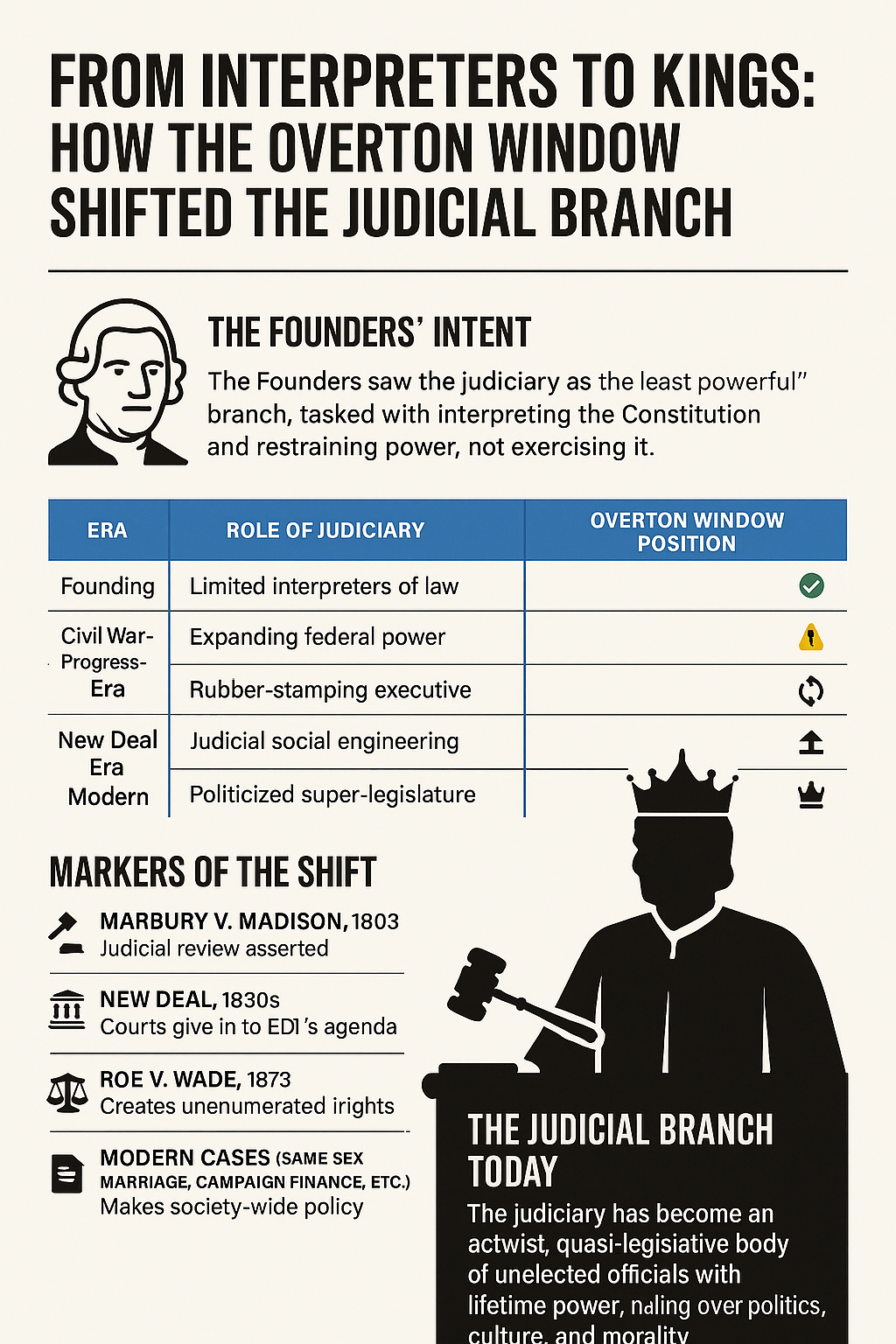Here’s a detailed article explaining how the Overton Window has moved the Judicial Branch of the United States—from its intended role as a constitutional guardian to what it increasingly resembles today: a politicized, activist, and unaccountable oligarchy cloaked in legal robes.
⚖️ From Guardians to Rulers: How the Overton Window Moved the Judicial Branch Away from the Founders’ Vision
“The judiciary, from the nature of its functions, will always be the least dangerous to the political rights of the Constitution.”
—Alexander Hamilton, Federalist No. 78
The Framers of the Constitution designed the Judicial Branch as the weakest of the three. Unlike Congress (which held the purse) or the Executive (which wielded the sword), the judiciary had only judgment—the power to interpret law, not create it, enforce it, or bend it to political whims.
But over time, the Overton Window has shifted dramatically. Today, the Judicial Branch wields a quasi-legislative, near-absolute power—deciding everything from marriage and abortion to economic regulation, executive privilege, and even electoral outcomes. In effect, judges have become philosopher-kings whose decisions shape the fabric of society, far beyond the bounds the Founders envisioned.
📜 I. What the Founders Intended for the Judiciary
The Founders believed in:
- Judicial restraint, not activism
- Interpretation of law, not creation of law
- Subservience to the Constitution, not to politics or ideology
- Limited jurisdiction, especially over “political questions”
“Our peculiar security is in the possession of a written Constitution. Let us not make it a blank paper by construction.”
—Thomas Jefferson
🛑 The judiciary was meant to be a check, not a driver of political and cultural change.
🧭 II. The Overton Window: From Limited Arbiter to Legal Ruler
| Era | Role of Judiciary | Overton Window Position |
|---|---|---|
| Founding (1789–1850) | Interpreters of constitutional law | ✅ Original vision |
| Civil War–Progressive Era | Expanded federal power over states | ⚠️ Nationalization begins |
| New Deal Era (1930s–40s) | Court capitulates to FDR’s agenda | 🔁 Courts bend to executive |
| Warren Court (1950s–70s) | Judicial activism peaks | 📈 Courts redefine rights & culture |
| Modern Era (1980s–Today) | Politicized super-legislature | 🧨 Judicial supremacy becomes normalized |
🔨 III. Key Markers of the Shift
1. Marbury v. Madison (1803) – Power to strike down laws
- Established judicial review (not explicitly in the Constitution)
- Opened the door to future expansion
2. New Deal (1930s) – Rubber-stamping executive expansion
- FDR threatened to pack the court
- SCOTUS began upholding vast federal powers
3. Warren Court (1953–1969) – Judicial social engineering
- Brown v. Board, Miranda, Gideon, Griswold
- Intervened deeply in education, police procedures, and morality
- Shifted public acceptance toward courts as reformers
4. Roe v. Wade (1973) – Created rights not in Constitution
- Interpreted privacy into abortion law
- Courts took on legislative role
5. Modern Cases – Nationalizing moral and social policy
- Same-sex marriage, campaign finance, gun rights, and now speech
- Public increasingly sees Supreme Court as the final moral authority, not just legal
⚠️ IV. What the Shift Has Enabled
- Courts rule over culture, often against the will of the people
- Congress abdicates responsibility, letting courts handle controversial issues
- Judges legislate from the bench, with lifetime appointments
- Public treats SCOTUS like a political battleground, cheering decisions like sports fans
- The Constitution becomes a living document, meaning whatever judges say it means
🧠 V. Psychological & Societal Consequences
- Legal relativism replaces constitutional fidelity
- Judicial supremacy undermines self-governance
- Citizens look to courts, not laws or principles, for social change
- Stage 4 legalism: People accept court rulings as moral truth simply because they’re “legal”
💥 VI. The Judicial Branch Today: A New Ruling Class?
Today’s judiciary often functions as:
- An unelected oligarchy
- Immune from democratic accountability
- Privileged with lifetime power
- Politically strategic in timing rulings (e.g., election years)
- Deeply embedded in partisan narratives
Even originalist justices can succumb to pressure, media framing, or personal legacies.
🧭 VII. What Must Shift Back?
To restore balance:
- Reassert constitutional interpretation over judicial philosophy
- Require jurisdictional restraint
- Encourage Congress to legislate rather than defer
- Reject the myth of judicial infallibility
- Educate the public on the limits of judicial power
🔚 Conclusion: The Robed Revolution
The Founders envisioned judges as servants of the Constitution, not masters over the people. But the Overton Window has shifted so far that we now normalize unelected judges making cultural, economic, and moral policy for 330 million citizens.
“To consider the judges as the ultimate arbiters of all constitutional questions… is a very dangerous doctrine indeed.”
—Thomas Jefferson
Until the public demands a return to constitutional limits, the judicial robe will continue to serve as the new crown of kings—kings not elected, not accountable, and not constrained.






